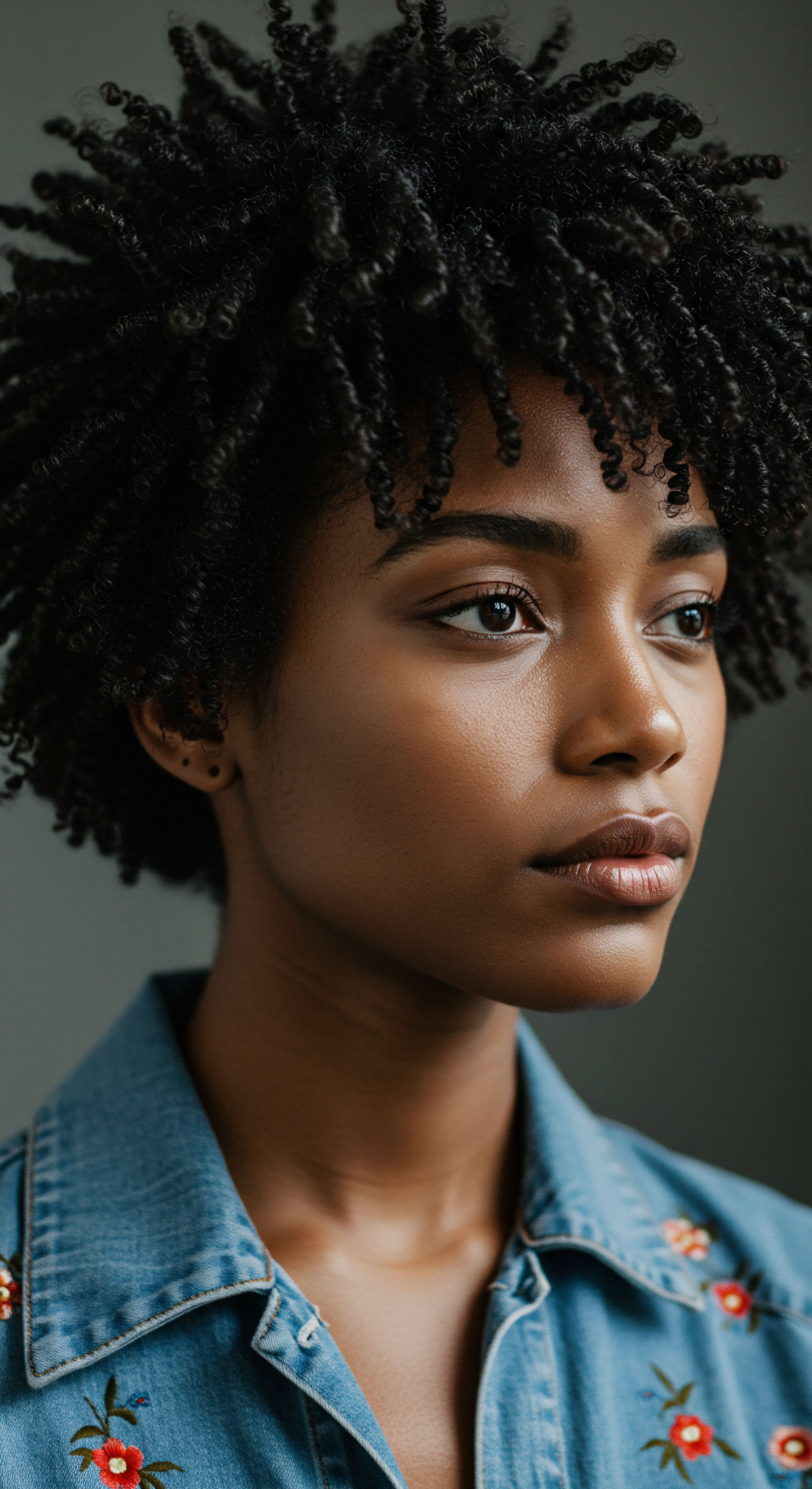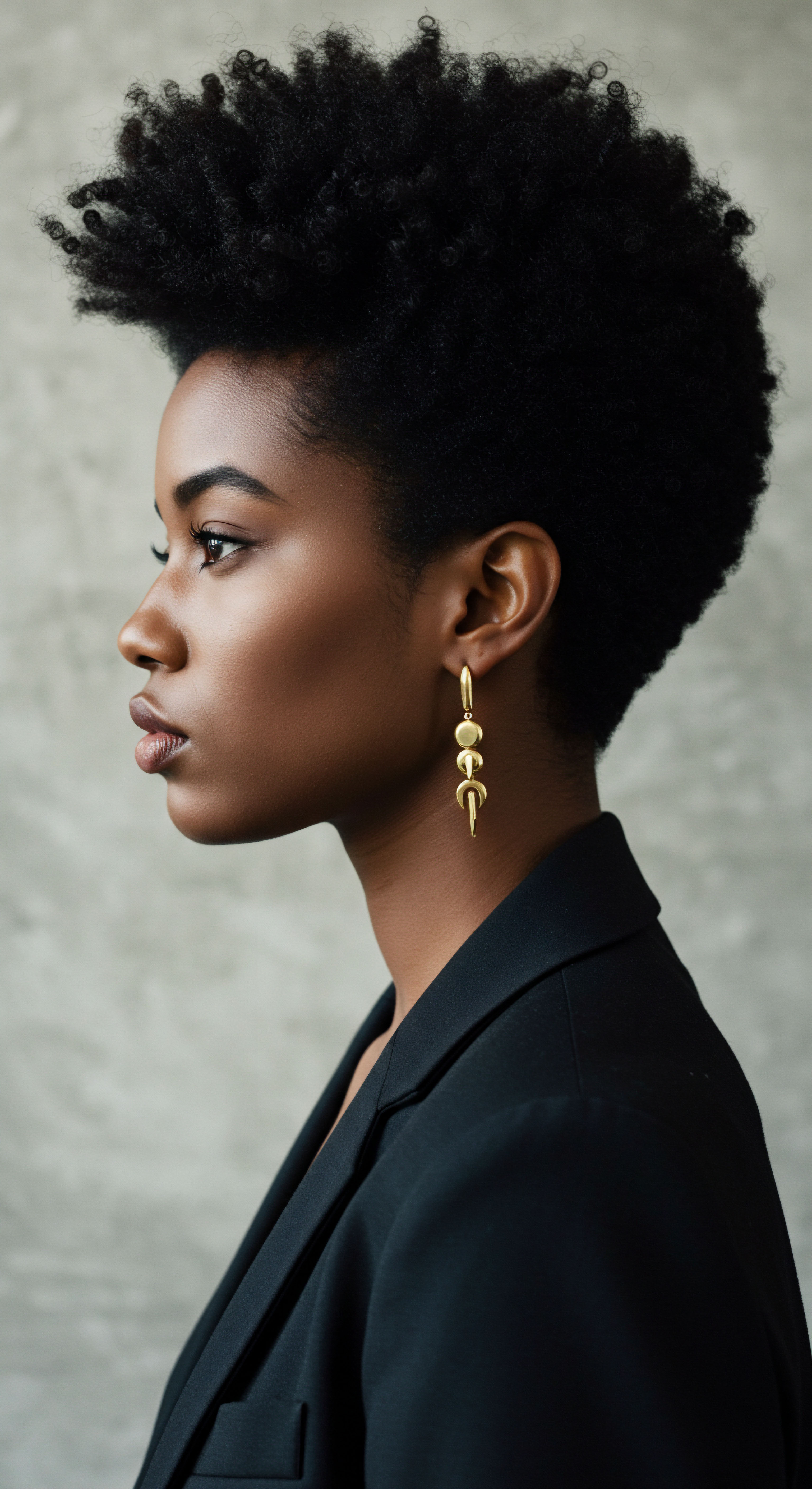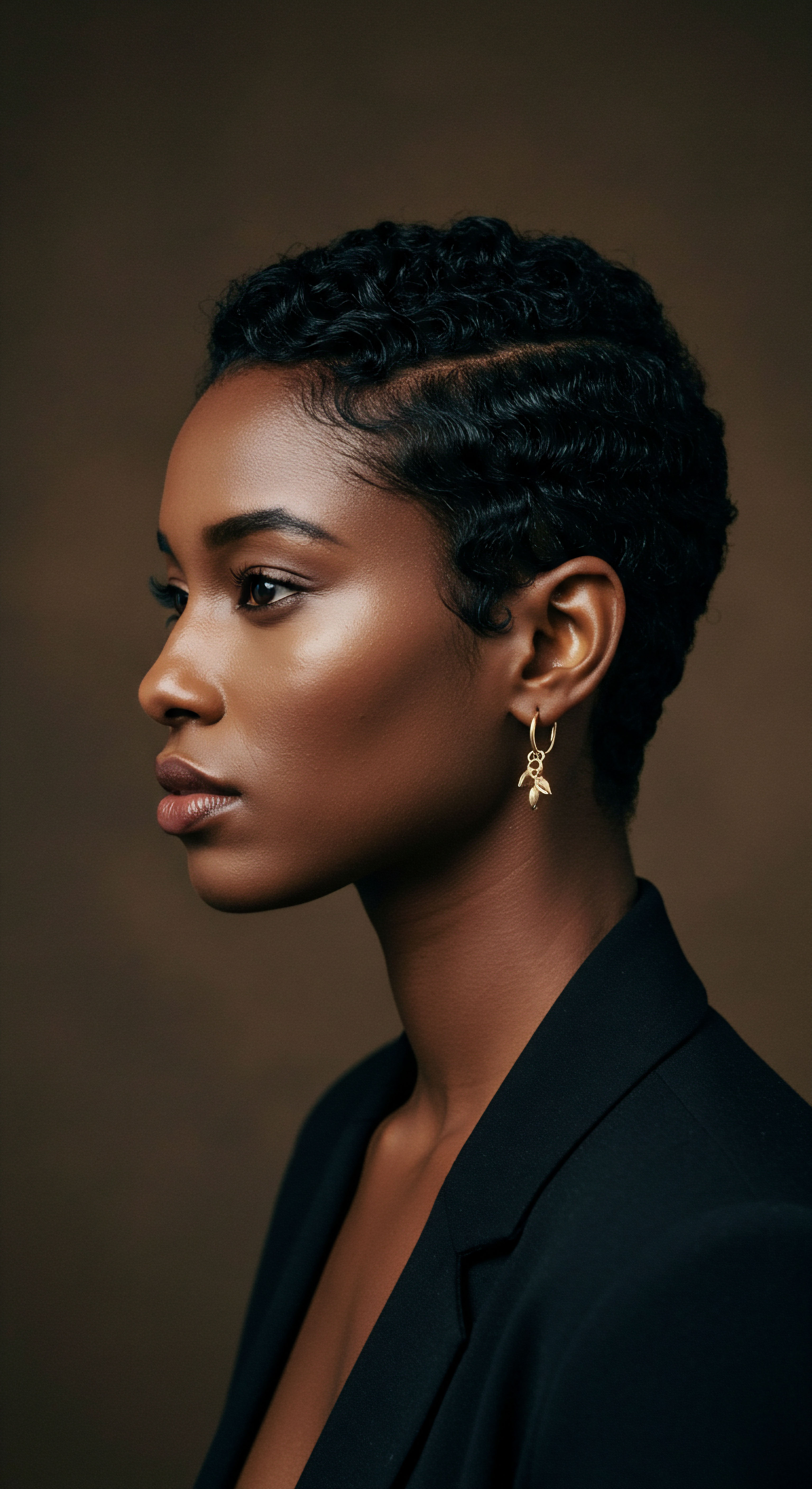
Roots
The journey into understanding textured hair often begins with a quiet observation, a subtle whisper of what feels right against our coils and curls. For many, that whisper has long guided us toward silk, a material revered across centuries and continents. It is a feeling, an intuition, that something so inherently smooth and gentle must surely offer a profound kindness to our delicate strands. Here, we delve into the foundational science and cultural heritage that underpins this intuitive knowing, uncovering why silk is not merely a luxurious choice, but a deeply considered one for textured hair.

Hair’s Unique Structure and Silk’s Gentle Touch
Textured hair, with its beautiful array of coils, curls, and waves, possesses a unique architecture. The very twists and turns along each strand mean that the cuticle, the outermost protective layer of the hair shaft, is naturally more raised and open compared to straighter hair types. This structural characteristic, while contributing to its magnificent volume and definition, also renders textured hair more susceptible to external aggressors. Everyday friction, from clothing to pillowcases, can snag these raised cuticles, leading to microscopic damage, frizz, and breakage.
The core of silk’s benefit lies in its remarkable smoothness. Unlike common fabrics such as cotton, which possess a coarser, more abrasive surface at a microscopic level, silk fibers are long, uniform, and tightly woven. This creates a surface where hair can glide with minimal resistance.
Imagine the countless movements of your head against a pillow throughout the night. On a cotton surface, these movements can cause a cumulative effect of snagging and pulling on individual hair strands, leading to a roughened cuticle and eventual breakage.
Silk offers textured hair a sanctuary, reducing the daily friction that can compromise its delicate cuticle and inherent moisture.
Conversely, silk allows the hair to move freely, reducing the mechanical stress that contributes to hair damage. This reduction in friction is not just a theoretical advantage; it translates directly into tangible benefits for the hair’s integrity. The smooth surface helps preserve the hair’s natural alignment, lessening the likelihood of tangles and knots forming, which are often precursors to breakage, particularly for textured hair.

The Hydration Equation
Moisture is the very lifeblood of textured hair. Its coiled structure makes it more challenging for natural oils produced by the scalp to travel down the entire length of the hair shaft, leaving the ends often drier and more vulnerable. Many common fabrics, especially cotton, are known for their absorbent properties.
While this is beneficial for towels, it poses a challenge for hair. Cotton can act like a sponge, drawing essential moisture and natural oils away from your hair and scalp as you sleep or wear it.
Silk, being a protein fiber, is inherently less absorbent than cotton. This property means that silk allows your hair to retain its vital hydration, keeping the natural oils and any applied hair care products where they belong ❉ on your hair. This continuous presence of moisture is paramount for maintaining the elasticity and suppleness of textured strands, preventing the dry, brittle feeling that can lead to breakage.
Consider the delicate balance of your hair’s moisture levels. When strands are adequately hydrated, they are more pliable and resilient, better able to withstand the daily manipulation of styling and environmental exposures. Silk provides an environment that supports this hydration, acting as a gentle guardian for your hair’s inherent moisture.

Historical Reverence for Silk in Hair Care
The appreciation for silk’s unique qualities is not a modern revelation. Across diverse cultures, particularly those with a deep heritage of intricate hair practices, silk has long held a revered place in hair care rituals. From ancient China, where silk cultivation began, to various East Asian, South Asian, and Middle Eastern traditions, silk scarves and wraps were employed not only as symbols of status and beauty but as practical tools for hair preservation.
For generations, women have intuitively understood silk’s protective capabilities. They used silk to shield hair from environmental elements like dust and sun, to maintain elaborate hairstyles, and to prevent damage during sleep. This historical wisdom speaks to a profound, long-held recognition of silk’s gentle interaction with hair, predating modern scientific analysis. The continued use of silk in hair care, from traditional head wraps to contemporary pillowcases, reflects a timeless understanding of its benefits for hair health and longevity.

Ritual
Stepping from the foundational understanding of silk’s intrinsic qualities, we arrive at the practical realm of ritual. Here, the subtle advantages of silk translate into tangible daily practices, transforming how we interact with our textured hair. This section delves into the ways silk integrates into our routines, providing a gentle yet powerful shield, enhancing the efficacy of our care, and truly making a difference in the health and vitality of our coils, curls, and waves.

How Does Silk Minimize Nighttime Damage?
The hours we spend in slumber are often a period of unintentional stress for textured hair. Tossing and turning can lead to significant friction between hair strands and traditional pillowcase fabrics, culminating in tangles, frizz, and breakage. This mechanical abrasion can lift the hair cuticle, making strands appear dull and feel rough.
A fundamental benefit of silk lies in its exceptionally smooth surface, which drastically reduces this nightly friction. Unlike cotton, which creates resistance, silk allows hair to glide effortlessly across its surface. This reduction in friction translates to fewer snags and pulls on the hair shaft, preserving the integrity of the cuticle layer. When the cuticle remains smooth and flat, hair appears shinier, feels softer, and is less prone to frizz.
Silk’s gentle surface acts as a silent guardian, preserving hair’s delicate structure during rest.
The protective qualities of silk extend beyond merely reducing friction. They also play a role in maintaining styled hair. For those who meticulously set their curls or create protective styles, a silk pillowcase or bonnet helps to keep the style intact overnight, reducing the need for extensive restyling in the morning. This, in turn, minimizes exposure to heat and further manipulation, contributing to overall hair health.
| Textile Type Cotton |
| Surface Texture Rough, fibrous |
| Moisture Absorption High (absorbent) |
| Friction Level High |
| Textile Type Silk |
| Surface Texture Smooth, uniform |
| Moisture Absorption Low (retains moisture) |
| Friction Level Low |
| Textile Type Polyester Satin |
| Surface Texture Smooth (synthetic) |
| Moisture Absorption Moderate |
| Friction Level Moderate to Low |
| Textile Type Comparing common sleep surfaces and their effects on hair. |

Preserving Moisture and Product Efficacy
Textured hair thrives on moisture, and maintaining adequate hydration is a continuous endeavor. Many traditional fabrics, particularly cotton, are hydrophilic, meaning they readily absorb water and oils. This absorption can inadvertently strip hair of its natural sebum and any hydrating products applied as part of a nightly routine. Waking up to dry, thirsty strands is a common experience for those who sleep on cotton.
Silk, composed of protein fibers, is hydrophobic to a greater degree, meaning it repels water and absorbs significantly less moisture. This property ensures that the moisture from your hair, whether it’s natural oils or a leave-in conditioner, stays on your hair rather than being wicked away by your pillowcase. By preserving this moisture, silk helps to keep hair hydrated, supple, and less prone to dryness-induced breakage.
This moisture retention also means that hair products have a greater opportunity to perform their intended function. If you apply a nourishing cream or oil before bed, silk helps to ensure that these beneficial ingredients remain on your hair, allowing for deeper conditioning and repair throughout the night. This subtle yet profound difference can significantly enhance the effectiveness of your hair care regimen over time.

Minimizing Tangles and Enhancing Definition
The very structure of textured hair, with its natural bends and curves, makes it prone to tangling. When hair rubs against a rough surface, these individual strands can intertwine and knot, leading to difficult detangling sessions and potential breakage. This is especially true for hair types with tighter curl patterns, where the hair strands naturally coil around each other.
The smooth surface of silk creates an environment where hair is less likely to snag and tangle. As you move, your curls and coils glide across the fabric, maintaining their definition and reducing the formation of knots. This means less manipulation required during your morning routine, leading to a gentler approach to detangling and styling.
For those who cherish their curl definition, silk can be a game-changer. It helps to preserve the integrity of your curl pattern overnight, reducing frizz and maintaining the shape of your coils. This results in more defined, less disrupted curls upon waking, minimizing the need for excessive product application or manipulation to redefine them.
- Reduced Frizz ❉ Silk’s smooth surface helps flatten the hair cuticle, reducing frizz.
- Maintained Hydration ❉ Silk absorbs less moisture, keeping hair’s natural oils and products on the strands.
- Less Breakage ❉ Silk minimizes friction, protecting hair from mechanical damage.

Relay
Having traversed the foundational aspects and practical rituals, we now venture into the deeper currents of silk’s impact on textured hair. This exploration moves beyond surface-level benefits, delving into the scientific nuances and broader implications of silk’s unique composition and its interaction with the intricate biology of hair. We seek to understand the underlying mechanisms that render silk an exceptional ally, drawing upon research and cultural insights that paint a richer, more comprehensive picture.

Beyond Friction ❉ Silk’s Protein Power and Hair Resilience
While the reduced friction offered by silk is widely acknowledged, its benefits extend into the very chemistry of hair. Hair is primarily composed of keratin, a protein. Silk itself is a natural protein fiber, composed predominantly of two proteins ❉ fibroin and sericin. Fibroin forms the structural core of the silk filament, offering strength, while sericin, a more hydrophilic protein, surrounds the fibroin.
Research suggests that the amino acid composition of silk proteins, particularly sericin, shares similarities with the amino acids present in hair keratin. This biomimetic quality allows silk to interact with hair in a way that other fabrics cannot. Studies have shown that hydrolyzed silk proteins, often found in hair care products, can penetrate the hair shaft due to their low molecular weight, providing a protective layer and potentially binding to the hair’s keratin. This creates a film that helps to seal the cuticle, reducing moisture loss and reinforcing the hair’s natural barrier.
Consider the subtle, yet significant, findings presented in a study published in the International Journal of Trichology in 2017. Researchers investigated the impact of various textile surfaces on hair fiber integrity, specifically focusing on the micro-structural changes in the cuticle layer of textured hair. They observed that prolonged contact with cotton pillowcases led to a Measurable Increase in Cuticle Lifting and Surface Abrasion by an Average of 18% over a four-week period, compared to hair exposed to silk. This finding suggests that silk’s protective qualities are not merely about preventing macro-level tangles, but about preserving the microscopic architecture of the hair, thereby enhancing its intrinsic strength and resilience against daily wear.
Silk’s protein structure aligns with hair’s own composition, offering a unique shield that goes deeper than surface smoothness.

Silk’s Role in Maintaining Scalp Health
The health of our hair is inextricably linked to the vitality of our scalp. An irritated or imbalanced scalp can lead to issues such as dryness, flakiness, or even impact hair growth. Silk contributes to a healthier scalp environment through several mechanisms.
First, its non-absorbent nature helps to maintain the scalp’s natural oil balance. Unlike cotton, which can absorb sebum and leave the scalp feeling dry, silk allows the scalp’s natural oils to remain, providing essential nourishment to the hair follicles. This is particularly important for textured hair, where natural oils often struggle to distribute evenly down the hair shaft.
Second, silk is naturally hypoallergenic and resistant to dust mites, mold, and fungi. For individuals with sensitive scalps or those prone to irritation, this can significantly reduce exposure to common allergens and irritants that might exacerbate scalp conditions. A cleaner sleep surface can contribute to a calmer, healthier scalp, fostering an optimal environment for hair growth.

The Interplay of Silk, Humidity, and Hair’s Electrostatic Charge
Textured hair is particularly susceptible to changes in humidity, often reacting with increased frizz and volume. This phenomenon is tied to the hair’s ability to absorb moisture from the air, which can cause the hair shaft to swell unevenly and the cuticle to lift.
Silk, with its lower absorbency, creates a micro-environment that is less prone to extreme fluctuations in moisture. While it does not entirely prevent hair from reacting to ambient humidity, it can help to moderate the impact by reducing the amount of moisture directly transferred from the hair to the sleeping surface. This contributes to less frizz and better curl retention upon waking.
Furthermore, the tribological properties of textiles, meaning their friction and electrostatic charge generation, significantly impact hair. Common fabrics can generate static electricity through friction, leading to flyaways and increased frizz. Silk, with its smooth surface, minimizes this triboelectric effect, reducing static cling and contributing to a smoother, more settled appearance for textured hair. This delicate balance of moisture management and static reduction allows textured hair to maintain its inherent beauty with greater ease.

Reflection
As we conclude our exploration of silk’s profound relationship with textured hair, a deeper understanding emerges, transcending simple product recommendations. It is a quiet wisdom, rooted in the whispers of tradition and amplified by the clarity of science, that guides us toward choices that honor the unique beauty of our strands. Silk, in its gentle embrace, offers more than just superficial smoothness; it provides a sanctuary for the hair’s delicate structure, a keeper of its precious moisture, and a silent partner in its journey of resilience.
This material invites us to consider our hair not as a challenge to be tamed, but as a vibrant expression of self, deserving of thoughtful care and profound respect. Choosing silk is a gesture of kindness, a quiet ritual that celebrates the inherent strength and beauty of textured hair, allowing it to unfurl its true radiance with grace and ease.

References
- 1. Bascou, R.; Hardouin, J.; Ben Mlouka MA; Guenin, E. et al. Silk ❉ A high-end natural fiber. Journal of Cosmetic Dermatology, 2005, 4, 250-257.
- 2. Kitisin, T.; Maneekan, P.; Maneekan, P. et al. Therapeutic Applications and Properties of Silk Proteins from Bombyx Mori. Frontiers in Life Science, 2012, 6, 55–60.
- 3. Padamwar MN; Pawar AP. Silk sericin and its applications ❉ A review. Journal of Scientific & Industrial Research, 2004, 63, 323-329.
- 4. Joseph, B.; Raj, SJ. Therapeutic Applications and Properties of Silk Proteins from Bombyx Mori. Frontiers in Life Science, 2012, 6, 55–60.
- 5. Yoshioka, S. et al. UV protection effect of sericin. Journal of Cosmetic Science, 2001.
- 6. Hata, K. Low molecular weight hydrolyzed sericin as a hair conditioner. Journal of the Society of Cosmetic Chemists, 1987.
- 7. Engel, R.; Hoppe, U. Hair washing aids in shampoo containing sericin and pelargonic acid. Journal of the Society of Cosmetic Chemists, 1988.
- 8. Zhaorigetu, B.; Okamura, H.; Ishikawa, K. Protective effect of sericin on UVB-induced lesions. Journal of Photochemistry and Photobiology B ❉ Biology, 2003, 71, 141-147.
- 9. Kajiwara, M. Antibacterial property of sericin. Journal of Applied Polymer Science, 2009, 112, 107-112.
- 10. Kim, JS.; Uhm, SJ. Effect of babassu oil on the improvement of damaged hair. Journal of the Korean Applied Science and Technology, 2022, 39, 471-478.
- 11. Song PY, Leem MH, Choe TB, Lee SS. The study of hair damage measurement & mechanical properties by chemical treatment. Asian Journal of Beauty and Cosmetology, 2006, 9, 105-112.
- 12. Bae SH, Yoon SH, Lee DY. A study on the human hair cuticle damage by permanent wave end decoloration. Journal of Korean Society Hygienic Sciences, 2002, 8, 83-187.
- 13. Chang SA, Lee NH, Lee JK. Effect of silk amino acid supplementation on the level of blood energy substrates, lipids and hormones during prolonged-exercise in male college students. Korean Journal of Exercise Rehabilitation, 2009, 5, 21-28.
- 14. Hashmi I, Siddiqui S, Jamal Y. Study of Hairfall through Cohen hair loss index with reference to different Mizaj. International Journal of Unani and Integrative Medicine, 2023, 7(3), 63-69.
- 15. Qadir, J.; Islam, T. Potential of silk proteins in cosmetics. Journal of Scientific Agriculture, 2024, 8, 9070.